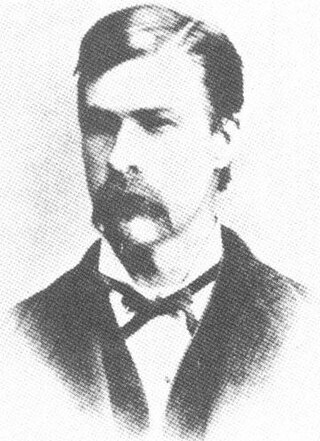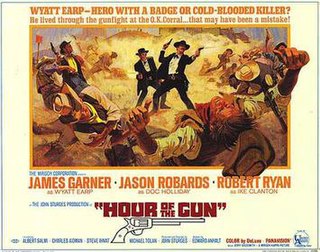
The gunfight at the O.K. Corral was a gunfight that lasted less than a minute between lawmen led by Virgil Earp and members of a loosely organized group of outlaws called the Cowboys that occurred at about 3:00 p.m. on Wednesday, October 26, 1881, in Tombstone, Arizona Territory, United States. It is generally regarded as the most famous gunfight in the history of the American Old West.

Virgil Walter Earp was both deputy U.S. Marshal and Tombstone, Arizona, City Marshal when he led his younger brothers Wyatt and Morgan, and Doc Holliday, in a confrontation with outlaw Cowboys at the Gunfight at the O.K. Corral on October 26, 1881. They killed brothers Tom and Frank McLaury and Billy Clanton. All three Earp brothers had been the target of repeated death threats made by the Cowboys who were upset by the Earps' interference in their illegal activities. All four lawmen were charged with murder by Ike Clanton, who had run from the gunfight. During a month-long preliminary hearing, Judge Wells Spicer exonerated the men, concluding they had been performing their duty.

Tombstone is a 1993 American Western film directed by George P. Cosmatos, written by Kevin Jarre, and starring Kurt Russell and Val Kilmer, with Sam Elliott, Bill Paxton, Powers Boothe, Michael Biehn, and Dana Delany in supporting roles, as well as narration by Robert Mitchum.

Morgan Seth Earp was an American sheriff and lawman. He served as Tombstone, Arizona's Special Policeman when he helped his brothers Virgil and Wyatt, as well as Doc Holliday, confront the outlaw Cochise County Cowboys in the Gunfight at the O.K. Corral on October 26, 1881. All three Earp brothers had been the target of repeated death threats made by the Cowboys who were upset by the Earps' interference in their illegal activities. The lawmen killed Cowboys Tom and Frank McLaury and Billy Clanton. All four lawmen were charged with murder by Billy's older brother, Ike Clanton, who had run from the gunfight. During a month-long preliminary hearing, Judge Wells Spicer exonerated the men, concluding they had been performing their duty.

Gunfight at the O.K. Corral is a 1957 American Western film starring Burt Lancaster as Wyatt Earp and Kirk Douglas as Doc Holliday, and loosely based on the actual event in 1881. The film was directed by John Sturges from a screenplay written by novelist Leon Uris. It was a remake of the 1939 film Frontier Marshall starring Randolph Scott, which was until 1957 the definitive film of the gunfight story.

Joseph Isaac Clanton was a member of a loose association of outlaws known as The Cowboys who clashed with lawmen Wyatt, Virgil and Morgan Earp as well as Doc Holliday. On October 26, 1881, Clanton was present at the Gunfight at the O.K. Corral in the boomtown of Tombstone, Arizona Territory but was unarmed and ran from the gunfight, in which his 19-year-old brother Billy was killed.

Tombstone, the Town Too Tough to Die is a 1942 American Western film about the Gunfight at the OK Corral. It is directed by William McGann and stars Richard Dix as Wyatt Earp, Kent Taylor as Doc Holliday and Edgar Buchanan as Curly Bill Brocious. The supporting cast features Rex Bell as Virgil Earp and Victor Jory as Ike Clanton.

Wyatt Earp is a 1994 American epic biographical Western drama film directed and produced by Lawrence Kasdan, and co-written by Kasdan and Dan Gordon. The film covers the lawman of the same name's life, from an Iowa farmboy, to a feared marshal, to the feud in Tombstone, Arizona that led to the O.K. Corral gunfight. Starring Kevin Costner in the title role, it features an ensemble supporting cast that includes Gene Hackman, Mark Harmon, Michael Madsen, Bill Pullman, Dennis Quaid, Isabella Rossellini, Tom Sizemore, JoBeth Williams, Mare Winningham and Jim Caviezel in one of his earliest roles.

Hour of the Gun is a 1967 Western film depicting Wyatt Earp and Doc Holliday during their 1881 battles against Ike Clanton and his brothers in the Gunfight at the O.K. Corral, and the gunfight's aftermath in and around Tombstone, Arizona, starring James Garner as Earp, Jason Robards as Holliday, and Robert Ryan as Clanton. The film was directed by John Sturges.

James Cooksey Earp was a lesser known older brother of Old West lawman Virgil Earp and lawman/gambler Wyatt Earp. Unlike his brothers, he was a saloon-keeper and was not present at the Gunfight at the O.K. Corral on October 26, 1881.

Frontier Marshal is a 1934 American Pre-Code Western film directed by Lewis Seiler and starring George O'Brien. Produced by Fox Film and Sol M. Wurtzel, the film is the first based on Stuart N. Lake's enormously popular but largely fictitious "biography" of Wyatt Earp, Wyatt Earp: Frontier Marshal. A second version of the film, also produced by Wurtzel, was made in 1939, and a third interpretation by John Ford entitled My Darling Clementine was released in 1946.

Frontier Marshal is a 1939 American Western film directed by Allan Dwan and starring Randolph Scott as Wyatt Earp. The film is the second produced by Sol M. Wurtzel based on Stuart N. Lake's biography of Earp Wyatt Earp: Frontier Marshal. An earlier version was Wurtzel's Frontier Marshal, filmed in 1934. The film was remade by John Ford in 1946 as My Darling Clementine, including whole scenes reshot from the 1939 film.

Wyatt Earp: Frontier Marshal (1931) was a best-selling biography of Wyatt Earp written by Stuart N. Lake and published by Houghton Mifflin Company. It was the first biography of Earp, written with his contributions. It established the Gunfight at the O.K. Corral in the public consciousness and conveyed an extraordinary story about Wyatt Earp as a fearless lawman in the American Old West. Earp and his wife Josephine Earp tried to control the account, threatening legal action to persuade Lake to exclude Earp's second wife from the book. When the book was published, neither woman was mentioned.

Tom McLaury was an American outlaw. He and his brother Frank owned a ranch outside Tombstone, Arizona, Arizona Territory during the 1880s. He was a member of a group of outlaws Cowboys and cattle rustlers that had ongoing conflicts with lawmen Wyatt, Virgil, and Morgan Earp. The McLaury brothers repeatedly threatened the Earps because they interfered with the Cowboys' illegal activities. On October 26, 1881, Tom and Frank were both killed in the Gunfight at the O.K. Corral in Tombstone, Arizona Territory. The Tombstone shootout was his only gunfight.

William Harrison Clanton was an outlaw Cowboy in Cochise County, Arizona Territory. He, along with his father Newman Clanton and brother Ike Clanton, worked a ranch near the boomtown of Tombstone, Arizona Territory and stole livestock from Mexico and later U.S. ranchers.

Doc is a 1971 American Western film, which tells the story of the Gunfight at the O.K. Corral and of one of its protagonists, Doc Holliday. It stars Stacy Keach, Faye Dunaway, and Harris Yulin. It was directed by Frank Perry. Pete Hamill wrote the original screenplay. The film was shot in Almeria in southern Spain.

The O.K. Corral was a livery and horse corral from 1879 to about 1888 in the mining boomtown of Tombstone, Arizona Territory, in the southwestern United States near the border with Mexico.

The O.K. Corral hearing and aftermath was the direct result of the 30-second Gunfight at the O.K. Corral in Tombstone, Arizona Territory, on October 26, 1881. During that confrontation, Deputy U.S. Marshal and Tombstone Town Marshal Virgil Earp, Assistant Town Marshal Morgan Earp, and temporary deputy marshals Wyatt Earp and Doc Holliday shot and killed Billy Clanton, and Tom and Frank McLaury. Billy's brother Ike, who had repeatedly threatened to kill the Earps for some time, had been present at the gunfight but was unarmed and fled. As permitted by territory law, he filed murder charges against the Earps and Doc Holliday on October 30.

Wyatt Earp was an American Old West lawman and gambler in Cochise County, Arizona Territory, and a deputy marshal in Tombstone, Arizona Territory.

Wyatt Earp's fame and reputation has varied through the years. While alive, he had many admirers and detractors. Among his peers near the time of his death, Wyatt Earp was respected. His deputy Jimmy Cairns described Earp's work as a police officer in Wichita, Kansas. "Wyatt Earp was a wonderful officer. He was game to the last ditch and apparently afraid of nothing. The cowmen all respected him and seemed to recognize his superiority and authority at such times as he had to use it." He described Wyatt as "...the most dependable man I ever knew; a quiet, unassuming chap who never drank and in all respects a clean young fellow..."



















